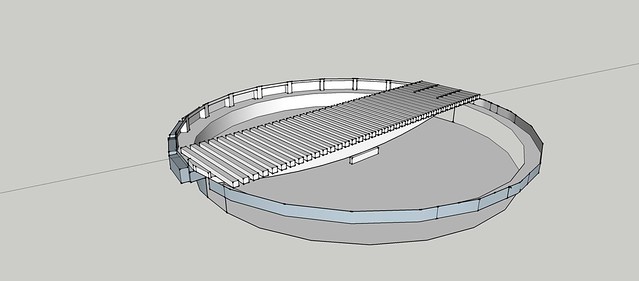One of the benefits of modelling a long-gone, poorly documented prototype is that occasionally you get to choose. Maybe you could call it a “benefit.” I’m not so sure, it tends to send me into a whirlpool of research, trying to find typical practices to inform my decision. So it was today when I started to think about making the pit for the turntable. How was the pit wall likely to have been constructed?
The obvious choice would be concrete. The PS employed concrete in the abutments and piers for the crossing of the Bonnechere River at Golden Lake. So, we know that this was possible.
However, wouldn’t it be fun if it looked like this one at Orangeville (from http://trainweb.org/oldtimetrains/whatsnew_2010.htm)? This one looks like a timber pit wall (note also the frogs on the near three tracks).

So, I abandoned the styrene for now, and went back to the virtual world. First I had to figure out the height of the pit wall. I figure on using some 28″ N scale wheels for the ring rail, which scale out to about 15.25″ in HO. So, the overall height of the wall comes out to about 2’4″.
The timbers change from 12×12 to 8×8 about half-way along. I think it looks closer to the Orangeville photo with 8×8 timbers. But in either case, the Orangeville pit looks deeper.
Timber construction like this makes me wonder about the footing for the ring rail. Unfortunately, all the turntables in Bush’s book have concrete or masonry pit walls. He doesn’t indicate much about pit construction at all.

I’ll admit I quite like the look of the frogs in the approach tracks. It woudl be some fun track to build with a potential benefit of saving a bit of space too.
The pits the Intercolonial built here on PEI were all concrete. That said, several were originally enclosed and those had a full deck (not unlike the classic HO scale Atlas one). Not sure how those would have been framed.
Cheers
/chris
I also think the frogs would be interesting. This arrangement makes the angle between stalls smaller for a narrower roundhouse further from the pit. In my case, where I know the dimensions of the front wall of the engine house, the roundhouse would wind up sitting so far from the turntable it would be in the river.
Thanks for the ICR data point. I am leaning more toward a concrete pit, based on my research.
Thanks!
Rene